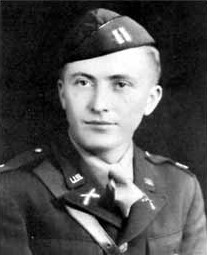On May 29, 1944, the War Department’s Bureau of Public Relations issued a two-page press release touting the leadership of Lt. Col. Lyle J. Deffenbaugh of Council Bluffs, Iowa, and the critical role he played in the fight for Mount Porchia, Italy, some months earlier.
In the narrative, which was sent to about a dozen newspapers, Maj. Robert W. Kane describes how Deffenbaugh went four days and nights without sleep as he personally led the drive to take the cold, windswept peak in early January 1944.

Lt. Col. Lyle J. Deffenbaugh
“On the night of January 4 our battalion was to make a night attack in conjunction with another Armored Infantry battalion against Mount Porchia,” Kane recounted. “Lt. Col. Deffenbaugh left me to take charge of the battalion command post so that he himself could go along with the assault companies because he said it was going to be one of the toughest battles we had ever had — and he wanted to be in it.”
Kane went on, describing how he had received reports of Deffenbaugh fighting his way to the departure line for the assault, then continuously moving from company to company providing encouragement over the coming days, all while under heavy German fire.
“I was at the battalion command post, and as the wounded were brought to the aid station, I asked many of them how it was and if they figured we would be able to get to the objective,” Kane continued. “Their answers were always about the same, ‘It is a tough battle, but we will get there because the Old Man is right up there with us.”
The press release describing Deffenbaugh’s heroics in Italy was exactly the kind of story the War Department loved to tell to everyone back home. A classic in the “local boy makes good” genre that undoubtedly led to a swelling of pride among Deffenbaugh’s family and friends in Iowa.
This particular bit of PR, though, came with a sad twist. Two weeks later, those same family and friends would learn that Lt. Col. Lyle J. Deffenbaugh had been killed in action in Italy on May 28, a day before the release was sent out.
Continue reading →


 Had he been born a quarter-century later, Robert M. Losey might have had a resume that stacked up well against any of the men who became household names to future generations.
Had he been born a quarter-century later, Robert M. Losey might have had a resume that stacked up well against any of the men who became household names to future generations.




